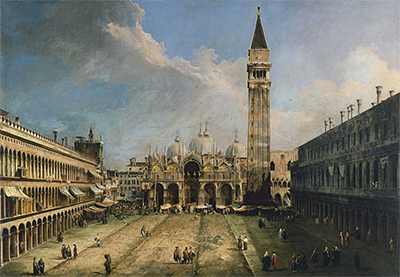The Piazza San Marco in Venice is typical of the atmospheric vistas painted by Giovanni Antonio Canal, more commonly known as Canaletto. Famous for his vedute, or city views, The Piazza San Marco in Venice depicts an almost bird's eye view of the expanse of St Mark's Square, the most famous square in Venice.
Thought to have been painted in 1723 or 1724, the location of St Mark's Square features multiple times throughout Canaletto's works of the 1720's and 1730's. Canaletto was born in Venice, so it is no surprise that this Venetian native should be so captivated by his own city. His paintings characteristically encompass intricate real-to-life details with dreamy, imaginary landscapes, also known as capricci, bringing architectural fantasy to famous landmarks. The Piazza San Marco in Venice however is one of his earlier works and concentrates more on a faithful representation of the Square, with its important features such as the Doge's Palace, the Campanile and the Procuratie. The Doge was a high ranking position found within Venetian society and many of those who served this role have been captured in portraits from some of the finest artists of the time, which was a means by which people could be recorded historically many centuries before the arrival of photography.
The shadows that fall across the right hand side of the Procuratie help to draw the eye up to the famous Campanile tower and across to the Doge's Palace, which gives the painting depth and perspective and contrasts with the softness of the clouds and hazy blue sky in the background. Venice. along with Rome and London, comprise much of his vedute works, with his skill at capturing a city skyline helping him to catch the eye of King George III of England, a country where he enjoyed much success. Canaletto had studied under Luca Carlevarijs, the artist credited for creating the vedute movement and he would often paint outside, focuses on his city and its famous landscapes. Not just a trained painter, the artist was also a printmaker too and skilled in etching, which is perhaps why many of his paintings are able to capture such small architectural details so effortlessly. He would, for example, lift the bar in this medium in the UK from his period living there.
Although he enjoyed much success throughout his career, many critics still cite his early works as his best, with many praising his use of colour and style as a precursor to what would eventually centuries later become known as Impressionism. The Piazza San Marco in Venice from circa 1723/1724 is currently on display at the Metropolitan Museum of Art in Manhattan, New York. This venue hosts an incredibly varied selection of art and antiquities which has been sourced from all manner of different cultures and civilisations, dating back thousands of years. In terms of paintings, the main focus is on American and European artists, with some of the highlights including the likes of Portrait of Madame X by John Singer Sargent, Mme Charpentier and Her Children by Pierre-Auguste Renoir, The Dancing Class by Edgar Degas and The Houses of Parliament (Effect of Fog) by Claude Monet.




